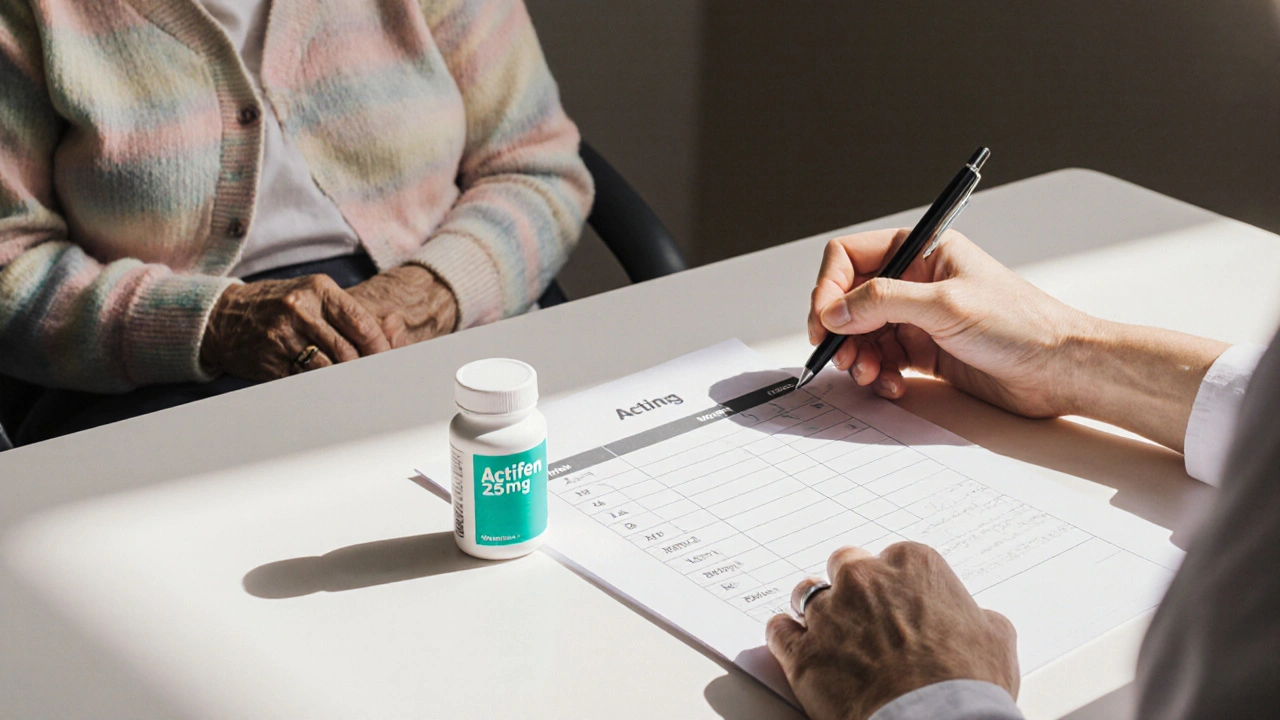Quick Summary
- Actifen can be a viable option for mild‑to‑moderate pain in older adults when used at low starting doses.
- Adjust the dose for renal or hepatic impairment and monitor for dizziness, constipation, or confusion.
- Avoid combining Actifen with other central nervous system depressants unless absolutely necessary.
- Regularly review the need for pain medication; taper off if pain improves.
- Actifen offers a smoother side‑effect profile than many NSAIDs for seniors with cardiovascular risk.
When managing pain in older adults, clinicians and caregivers often wrestle with balancing efficacy and safety. Actifen is a brand name for a formulation that contains tramadol, a centrally acting opioid analgesic. It’s marketed for moderate pain relief and is frequently considered when NSAIDs pose gastrointestinal or cardiovascular hazards. This guide walks through the pharmacology, dosing nuances, monitoring points, and real‑world tips that make Actifen a responsible choice for the elderly.
What is Actifen?
Actifen is a tablet containing 50mg of tramadol base. Tramadol works by binding to mu‑opioid receptors and also inhibiting the reuptake of norepinephrine and serotonin, giving it a dual mechanism that can help with both nociceptive and neuropathic pain. Unlike pure opioids, tramadol’s ceiling effect on respiratory depression makes it a somewhat safer entry point for older patients, provided the dose is kept low.
Why the Elderly Need Special Consideration
Physiological changes after age 65 affect drug absorption, distribution, metabolism, and excretion. Geriatric patients often have reduced renal clearance (average glomerular filtration rate drops 1mL/min per year after 40) and diminished hepatic enzyme activity, especially CYP2D6, which converts tramadol to its more potent metabolite O‑desmethyltramadol. These shifts increase the risk of accumulation, leading to sedation, falls, or respiratory compromise.
Safe Dosing Guidelines for Seniors
Start low, go slow. For most elderly individuals without significant organ impairment, the recommended initial dose is 25mg once daily, taken with food to lessen gastrointestinal upset. If tolerated, the dose can be increased by 25mg every 3-5days, never exceeding 100mg per day for patients over 75years old. In those with moderate renal (eGFR 30‑59mL/min) or hepatic dysfunction, cap the total daily dose at 50mg and extend the interval between doses.
Common Side Effects and What to Watch
Older adults are more sensitive to certain adverse effects. Typical reactions include:
- Dizziness or light‑headedness - raise fall risk.
- Constipation - consider a stool‑softening regimen from day1.
- Dry mouth and mild nausea - hydrate and use bland foods.
- Confusion or delirium, especially when combined with anticholinergics.
- Rarely, serotonin syndrome if taken with SSRIs or SNRIs.
Any sign of respiratory depression, severe hypersensitivity, or sudden increase in pain should trigger immediate medical review.
Key Drug Interactions
Because tramadol is metabolized by CYP2D6 and CYP3A4, inhibitors of these pathways can raise drug levels. Notable interactions include:
- Selective serotonin reuptake inhibitors (SSRIs) - heightened risk of serotonin syndrome.
- CYP2D6 inhibitors such as fluoxetine, paroxetine, or quinidine - reduced conversion to active metabolite, possibly lowering efficacy.
- CNS depressants (benzodiazepines, antihistamines, alcohol) - additive sedation and fall risk.
Always review a patient’s medication list before initiating Actifen and adjust doses accordingly.
Actifen Compared with Other Analgesics for the Elderly
| Agent | Typical Starting Dose (Elderly) | Metabolism | Renal Considerations | Main Side‑Effects |
|---|---|---|---|---|
| Actifen (tramadol) | 25mg once daily | CYP2D6 & CYP3A4 | Reduce dose if eGFR<60mL/min | Dizziness, constipation, serotonin syndrome |
| NSAIDs (e.g., ibuprofen) | 200mg 2-3times/day | Hepatic (CYP2C9) | Avoid if eGFR<30mL/min; risk of nephrotoxicity | GI bleeding, cardiovascular events |
| Codeine | 15‑30mg every 4-6h | CYP2D6 (activates to morphine) | Accumulate in renal impairment | Constipation, sedation, respiratory depression |
The table shows why Actifen often edges out NSAIDs for patients with cardiovascular disease or a history of ulcers, and why it may be preferable to codeine in those with variable CYP2D6 activity.

Practical Tips for Clinicians and Caregivers
Implementing a safe regimen is as much about process as about the drug itself. Follow this quick checklist:
- Verify renal (eGFR) and hepatic function labs before prescribing.
- Document all concurrent CNS depressants; consider dose reduction or alternative therapy.
- Start at 25mg once daily; reassess pain and side‑effects after 48hours.
- Educate the patient and caregiver about constipation prevention (fiber, fluids, stool softeners).
- Schedule a follow‑up call or visit within one week to adjust the dose.
- Use a pain diary to track effectiveness and any adverse signs.
When pain resolves or improves substantially, taper gradually-reduce the dose by 25mg every 3‑5days to avoid withdrawal symptoms.
When Not to Use Actifen
Even a relatively safe drug has contraindications. Avoid Actifen in seniors who have:
- Severe uncontrolled epilepsy (tramadol can lower seizure threshold).
- History of severe respiratory depression or untreated sleep apnea.
- Known hypersensitivity to tramadol or any of its excipients.
- Current high‑dose opioid therapy (risk of additive toxicity).
In those cases, explore non‑pharmacologic modalities-physical therapy, acupuncture, or topical agents like lidocaine patches.
Frequently Asked Questions
Can Actifen be used for chronic back pain in seniors?
Yes, but only after NSAIDs or acetaminophen have proved insufficient and after a careful assessment of kidney and liver function. Start at 25mg daily and titrate slowly, monitoring for dizziness and constipation.
Is it safe to combine Actifen with a low‑dose antidepressant?
Co‑administration with SSRIs or SNRIs can increase the risk of serotonin syndrome. If the combination is unavoidable, use the lowest possible tramadol dose, watch for agitation, fever, or muscle rigidity, and educate the patient to seek immediate help if symptoms appear.
What should I do if my elderly relative feels unusually sleepy after taking Actifen?
First, assess whether the dose is too high or if other sedatives are being taken at the same time. Reduce the tramadol dose by 25mg and observe for 48hours. If sleepiness persists, consult a clinician; dose adjustment or a switch to a non‑opioid analgesic may be needed.
How long does it take for Actifen to start relieving pain?
Onset of analgesia typically occurs within 30‑60minutes, with peak effect around 2‑3hours. For chronic conditions, steady‑state levels are reached after 2‑3 days of consistent dosing.
Is Actifen suitable for patients with mild cognitive impairment?
Caution is advised. Cognitive decline can mask early signs of sedation or confusion. Start at the lowest dose, involve a caregiver in monitoring, and reassess weekly. If any decline is noted, discontinue or switch to a non‑opioid option.
Can Actifen be stopped abruptly?
Abrupt discontinuation after regular use for more than a few weeks can trigger withdrawal symptoms such as anxiety, sweating, and flu‑like aches. Taper the dose gradually - reduce by 25mg every 3‑5days - under medical supervision.
By respecting the unique physiology of older adults and following the dosing and monitoring steps outlined above, Actifen can provide effective pain relief without compromising safety. Always collaborate with a healthcare professional to personalize therapy and revisit the pain management plan regularly.

6 Responses
It is imperative to acknowledge the delicate pharmacokinetic shifts that accompany aging, particularly the reduced renal clearance and hepatic enzyme activity.
Consequently, initiating Actifen at a conservative 25 mg dose aligns with best‑practice guidelines and mitigates the risk of accumulation.
Clinicians should also verify the patient’s eGFR prior to titration, adjusting the ceiling dose to 50 mg for those with moderate impairment.
Concurrent administration of anticholinergic agents should be avoided to prevent additive cognitive burden.
Overall, a judicious, stepwise approach fosters both analgesic efficacy and safety for our senior cohort.
Starting tramadol at a low dose is paramount for older adults, and the guide rightly suggests 25 mg once daily.
From a practical standpoint, I always advise caregivers to administer the dose with breakfast to reduce GI upset.
This timing also helps synchronise the analgesic effect with morning activity levels.
Another tip is to keep a simple dosing chart on the fridge; visual cues prevent accidental doubling.
If the patient tolerates the initial dose, a cautious increase of 25 mg every 3–5 days can be considered, never exceeding 100 mg per day for those over 75.
Renal function should be checked before each uptitration; an eGFR below 30 mL/min warrants a maximum of 50 mg daily.
Watch for dizziness-adding a low‑dose vitamin D supplement may aid balance, though evidence is modest.
Constipation is a frequent complaint; a stool softener like docusate started on day 1 can preempt the issue.
Hydration is equally important; aim for at least 1.5 L of fluid unless contraindicated.
Be wary of combining tramadol with SSRIs; the risk of serotonin syndrome, while rare, is not negligible.
Similarly, benzodiazepines should be avoided unless absolutely necessary, as they amplify sedation and fall risk.
For patients on antihistamines, consider switching to a non‑sedating alternative to minimise confusion.
Regular medication reviews, ideally every three months, help catch side‑effects early and allow dose reductions when pain improves.
Family members can play a role by monitoring mood changes, as tramadol can occasionally precipitate delirium.
Finally, educate the patient that any sudden increase in pain or breathing difficulty warrants immediate medical attention.
Indeed, the step‑wise dosing schedule you outlined is both pragmatic and evidence‑based, and I would add that monitoring for constipation from day one is essential.
Definately, a weekly review can catch subtle changes before they become problematic.
Stop sugar‑coating the risks; tramadol can precipitate severe sedation and even respiratory depression in frail elders, especially when combined with alcohol or benzodiazepines.
If you’re not closely monitoring blood gases and mental status, you’re basically courting disaster.
Tramadol.. is metabolized by CYP2D6 and CYP3A4!! So watch out for inhibitors---fluoxetine, paroxetine?? They *change* the whole pharmacodynamics.. Also, don’t forget to adjust dose !! if eGFR is low
Regular follow‑up visits are key to ensuring safe use.